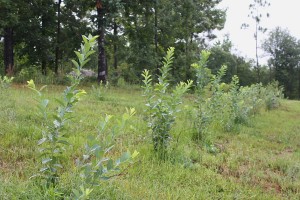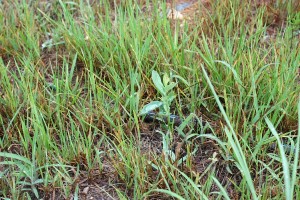In late January I inadvertently started a brush fire that threatened both the barn and the lodge. Fortunately, it inflicted damage on neither.
That doesn’t mean it didn’t take a toll, though. We didn’t realize it at the time, but the fire severely damaged several of our blueberry bushes and (apparently) killed a handful of them. Only one of our maturing bushes escaped undamaged.
The small plot of land we call the Blueberry Strip lies immediately north of the barn where Amanda and I live and contains (or contained before the fire) 41 blueberry bushes. You can be forgiven for asking why two subsistence farmers needed 41 blueberry bushes; the simplest answer is that blueberries are one of two “no-brainer” fruits that grow well in central Alabama with little or no fertilizer or other chemicals needed. We knew we “needed” 20 or so, and it was cheap and easy to add that many again so we could look forward to excess production for wine, jam, etc. and to give them away to friends and family.
I started the fire by burning some wood scraps on a Friday morning. After the fire burned down I discovered several cardboard boxes that I also needed to burn, but I needed to leave the farm to meet a friend in Prattville (about an hour away) for lunch, so I put the boxes down a few feet from where the fire had been burning and drove away. My friend was late, so I was gone from the farm for several hours. As I drove up I saw smoke enveloping the lodge and knew I was in trouble. What had happened, of course, is that the wind blew the boxes into the firebed, where the residual heat from the wood scraps was enough to ignite them, which in turn ignited the grass of the Blueberry Strip. By the time I had been gone several hours, the fire had slowly spread beyond the Blueberry Strip down the hill into the forest, as well as up the hill past the lodge and to the forest beyond it.
I grabbed my flapper (every landowner should own one) and started patrolling the leading edge of the fire while I called the Friendship Fire Department (I quickly realized I needed help). Within an hour after their arrival, the guys from Friendship had the fire fully under control.
Here are the ways in which we were very fortunate:
- Nobody got hurt.
- The fire burned within a few feet of both the barn and the lodge but inflicted no damage on either, not even the smell of smoke.
- The fire escaped into the forest but the wind was never strong enough to propel it into the tops of the trees. It moved at a sedate pace that allowed the firefighters and me to bring it under control before it burned more than a few acres. So at no point did the fire escape our property.

Nearly all the foliage you see in this shot is new growth during the spring. Ground zero of the January brushfire is just a few feet to the right of the frame.

This may look like just a weed springing up by the drip tape, but I recognize it as the new growth from the roots of the Austin blueberry that once grew more than three feet high in this spot.
Now about those blueberries. The plants were all dormant at the time of the fire, so I hoped they were undamaged. I didn’t fully realize just how devastating the fire had been until spring when it was time for them to bud out. Long past the time when they should have been putting on leaves and preparing to set fruit, the skeletons of the plants stood naked, mutely accusing their steward of berrycide. At first I was in despair, thinking that I was going to have to replant nearly every blueberry bush. With the passage of time, however, the news has gotten better, and then better still.
The fire destroyed the above-ground portion of nearly every plant. But the fire did not damage the roots of the plants, so they responded to the outrage inflicted upon them by pushing new growth up. I have almost no berries this year, of course, because they depend on last year’s growth and precious little of that made it. But I’m beginning to be optimistic about the Blueberry Strip in general. Of the 41 plants, I probably already had one or two that were dead or dying before the fire. Last week I counted a total of five plants that showed no signs of life at all, and yesterday morning I spotted some new growth coming from the roots of one of the five, so now we’re down to four. So I’m ready now to say that, although the fire inflicted lots of damage and set production back dramatically, it only killed two plants.
For this year, the damage is nearly total. In the long-term, though – and Longleaf Breeze makes no sense except as a long-term proposition – we’re very fortunate. I’ve lost a year or two of growth, but I hope and now expect that it won’t be long before I’ll need to come back and read this to remember how fire “destroyed” the Blueberry Strip back in 2013.
Pingback: What’s Happening To Our Figs? « Longleaf Breeze